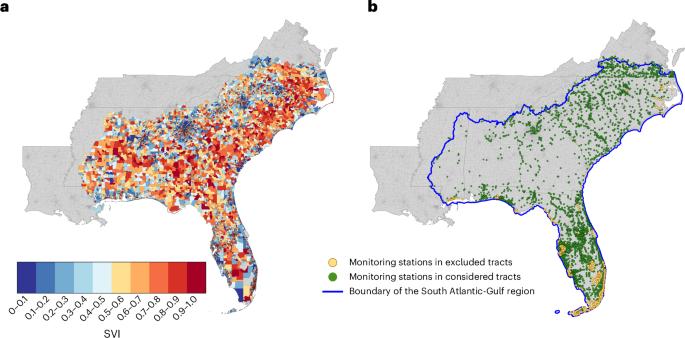Surface waters in socially vulnerable areas are disproportionately under-monitored for nutrients in the US South Atlantic-Gulf region
IF 24.1
引用次数: 0
Abstract
This study investigates whether active water quality monitoring stations are proportionately distributed across communities of varying social vulnerability. We specifically focus on nutrient monitoring of surface waters in the South Atlantic-Gulf region, a water-rich area with wide-ranging land uses and communities that span the social vulnerability spectrum. We used 2018–2022 data from the US Water Quality Portal to compare station locations to metrics from the US Centers for Disease Control Social Vulnerability Index (SVI) and hydrography from the US Geological Survey. Statistical analyses revealed a substantial imbalance in the distribution of active monitoring station placements, with more monitoring stations in lower vulnerability areas and fewer in high vulnerability areas, and patterns that vary by state. Stations were clustered in areas of similar SVI values; areas were less likely to be monitored if they were near tracts with differing SVI values. Water quality monitoring stations are crucial to ensure a timely response to any problem emerging across water resource networks. A study of nutrient monitoring of surface waters in the South Atlantic-Gulf region shows an inhomogeneous monitoring station distribution, with fewer stations in highly vulnerable areas.

在美国南大西洋-海湾地区,社会脆弱地区的地表水营养监测不足
本研究调查了活跃的水质监测站是否按比例分布在不同社会脆弱性的社区。我们特别关注南大西洋海湾地区地表水的营养监测,这是一个水资源丰富的地区,拥有广泛的土地利用和跨越社会脆弱性谱的社区。我们使用了美国水质门户网站2018-2022年的数据,将监测站的位置与美国疾病控制中心的社会脆弱性指数(SVI)和美国地质调查局的水文数据进行了比较。统计分析显示,活跃监测站的分布存在明显的不平衡,低脆弱性地区监测站较多,高脆弱性地区监测站较少,且分布模式因州而异。监测站聚集在SVI值相似的地区;如果靠近SVI值不同的区域,则不太可能受到监测。水质监测站对于确保及时应对水资源网络中出现的任何问题至关重要。对南大西洋-海湾地区地表水营养监测的一项研究表明,监测站分布不均匀,高度脆弱地区的监测站较少。
本文章由计算机程序翻译,如有差异,请以英文原文为准。
求助全文
约1分钟内获得全文
求助全文

 求助内容:
求助内容: 应助结果提醒方式:
应助结果提醒方式:


